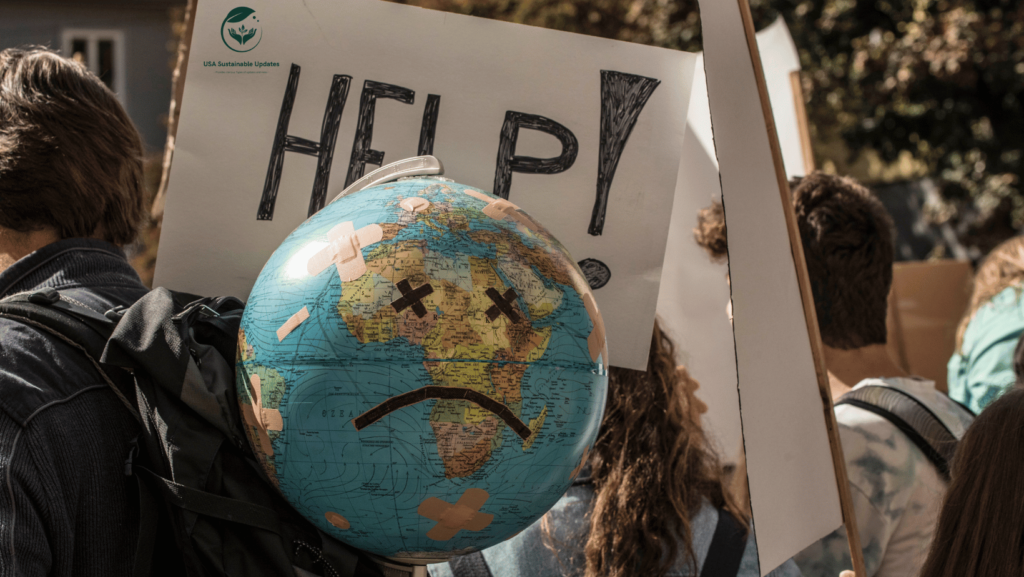What is the Climate Crisis? Understanding the Urgent Global Environmental Challenge
July 25, 2023 | by usasustainableupdates.com

Discover the climate crisis, a pressing global environmental challenge. Learn about its causes, impact, and solutions to combat this urgent issue. Get insights on how individuals and communities can take action.
Introduction
Climate change has emerged as one of the most critical issues of our time, and the term “climate crisis” has become increasingly common in scientific literature and media headlines. The rapid and unprecedented changes in Earth’s climate system demand urgent attention and action from every individual and nation. But what exactly is the climate crisis, and why is it so significant? In this comprehensive article, we will delve deep into the topic, examining the causes, consequences, and potential solutions to the climate crisis. From exploring the scientific underpinnings of global warming to understanding its multifaceted impact on the environment and human life, we’ll cover it all. So, let’s embark on a journey to understand the climate crisis and explore what actions we can take to address this urgent challenge.
Understanding Climate Crisis
At its core, the climate crisis, also known as global warming, refers to the long-term changes in Earth’s climate system characterized by rising average temperatures. These temperature increases, though seemingly small, have far-reaching consequences for our planet’s delicate ecosystems and the well-being of its inhabitants. The primary driver of this crisis is the excessive release of greenhouse gases into the atmosphere, creating a greenhouse effect that traps heat and leads to the warming of the planet. The key greenhouse gases responsible for this effect are carbon dioxide (CO2), methane (CH4), nitrous oxide (N2O), and fluorinated gases.

The Causes of the Climate Crisis
The climate crisis is predominantly driven by human activities. While natural factors can influence the climate, the accelerated pace of global warming observed in recent decades can be attributed to human-induced activities, including:
- Burning of Fossil Fuels: The combustion of fossil fuels, such as coal, oil, and natural gas, for energy production and transportation releases massive amounts of carbon dioxide into the atmosphere. This release of CO2 contributes significantly to the overall greenhouse gas concentration, creating a thick blanket of heat-trapping gases around the Earth.
- Deforestation: Large-scale deforestation and forest degradation result in the reduction of trees available to absorb CO2 through photosynthesis. As a consequence, the excess carbon dioxide in the atmosphere contributes to the greenhouse effect, leading to higher global temperatures.
- Industrial Emissions: Industries release greenhouse gases during various manufacturing processes, such as cement production and chemical manufacturing. The extraction and processing of raw materials, as well as the burning of fossil fuels in industrial settings, contribute to the overall concentration of these gases in the atmosphere.
- Agriculture: Agricultural practices contribute to greenhouse gas emissions in several ways. Livestock farming, for instance, produces methane during the digestive process of ruminant animals like cows and sheep. Additionally, the use of nitrogen-based fertilizers results in the release of nitrous oxide, another potent greenhouse gas.
- Waste Management: The improper disposal of organic waste in landfills leads to the production of methane during the decomposition process, further adding to the greenhouse effect. Inefficient waste management practices exacerbate the climate crisis.

The Impact of Climate Crisis
The consequences of the climate crisis are far-reaching and affect various aspects of the planet and its inhabitants:
- Rising Sea Levels: Melting glaciers and ice sheets result in the expansion of seawater, causing sea levels to rise. This poses a significant threat to coastal communities and low-lying areas, leading to increased incidents of flooding and coastal erosion. As sea levels continue to rise, coastal infrastructure and habitats are at risk, forcing millions of people to relocate.
- Extreme Weather Events: Global warming intensifies extreme weather events, including hurricanes, heatwaves, floods, and droughts. These events can have devastating impacts on ecosystems, infrastructure, agriculture, and human settlements. The frequency and intensity of these extreme events are projected to increase as the climate crisis worsens.
- Loss of Biodiversity: Climate change disrupts ecosystems, leading to shifts in habitats and ecosystems. As a result, many plant and animal species struggle to adapt to the changing conditions, leading to the potential extinction or migration of numerous species, thus threatening biodiversity. The loss of biodiversity can have cascading effects on ecosystem services and human well-being.
- Threat to Agriculture: Changing weather patterns and unpredictable climate conditions pose significant challenges to agriculture. Shifts in precipitation patterns, temperature extremes, and the spread of pests and diseases can disrupt crop yields and food production, affecting food security. This can result in food shortages and price fluctuations, impacting vulnerable populations disproportionately.
- Human Health: Climate change directly and indirectly impacts human health. Rising temperatures can lead to heat-related illnesses and heat stress, particularly in urban areas with limited green spaces and extreme heat events. Changes in precipitation patterns can affect the spread of waterborne diseases, while increased air pollution from wildfires and other sources can worsen respiratory conditions and cardiovascular health.

Addressing the Climate Crisis
Addressing the climate crisis requires collective efforts at all levels, from individual actions to international cooperation. Here are some key strategies that can make a difference:
- Transition to Renewable Energy: Shifting from fossil fuels to renewable energy sources like solar, wind, and hydroelectric power is crucial in reducing greenhouse gas emissions and mitigating the impact of the climate crisis. Embracing clean energy technologies can pave the way towards a sustainable energy future. Governments, businesses, and individuals can invest in renewable energy infrastructure and promote clean energy policies.
- Afforestation and Reforestation: Planting trees and restoring forests are effective ways to sequester carbon dioxide from the atmosphere. Trees act as carbon sinks, absorbing CO2 during photosynthesis and storing it as biomass. Large-scale afforestation and reforestation projects can help offset emissions and combat deforestation. Community-led tree planting initiatives and sustainable forestry practices can contribute to the restoration of degraded lands.
- Energy Efficiency: Improving energy efficiency in industries, buildings, and transportation can significantly reduce energy consumption and, consequently, greenhouse gas emissions. Energy-efficient technologies, smart urban planning, and sustainable transportation systems can collectively reduce our carbon footprint.
- Sustainable Agriculture: Adopting sustainable agricultural practices can play a vital role in mitigating the climate crisis. Practices such as agroforestry, organic farming, and precision agriculture can help sequester carbon in the soil and reduce greenhouse gas emissions from agricultural activities. Additionally, reducing food waste and promoting plant-based diets can lessen the environmental impact of the food system.
- Climate Education and Awareness: Raising awareness about the climate crisis and its implications is essential in fostering public support and individual action. Education campaigns, workshops, and outreach programs can empower people to make informed decisions and take climate-friendly actions in their daily lives.
- International Cooperation: The climate crisis is a global challenge that requires international cooperation and collaboration. Countries must work together to set ambitious emission reduction targets, share knowledge and technology, and support vulnerable nations in adapting to the impacts of climate change. International agreements and forums, such as the United Nations Framework Convention on Climate Change (UNFCCC) and the Conference of the Parties (COP), provide platforms for global collaboration.
- Innovative Technologies: Investing in and promoting innovative technologies, such as carbon capture and storage (CCS), can help remove CO2 from the atmosphere. Research and development in green technologies and sustainable practices can pave the way for a more climate-resilient future.

Frequently Asked Questions (FAQs)
Q: What is the primary cause of the climate crisis? A: The primary cause of the climate crisis is the excessive release of greenhouse gases into the atmosphere due to human activities, such as burning fossil fuels, deforestation, and industrial emissions.
Q: How does the climate crisis impact biodiversity? A: The climate crisis disrupts ecosystems and habitats, leading to shifts in biodiversity. Many plant and animal species face challenges in adapting to changing conditions, leading to potential extinctions or migrations.
Q: Can individual actions make a difference in addressing the climate crisis? A: Yes, individual actions play a crucial role in addressing the climate crisis. Simple changes in daily habits, such as reducing energy consumption, using public transportation, and supporting sustainable products, collectively contribute to a more sustainable future.
Q: Is the climate crisis reversible? A: While some of the damage caused by the climate crisis may be irreversible, taking immediate and drastic actions can still help prevent further catastrophic consequences. Reducing greenhouse gas emissions and implementing sustainable practices can slow down the rate of warming.
Q: What is the role of governments in addressing the climate crisis? A: Governments play a pivotal role in addressing the climate crisis. They can enact policies and regulations to reduce greenhouse gas emissions, promote renewable energy, and support sustainable practices. International cooperation through agreements like the Paris Agreement is also critical in tackling the global nature of the crisis.
Q: How can we prepare for the impacts of climate change? A: Preparedness involves investing in climate-resilient infrastructure, disaster management, and educating communities about climate-related risks. Building adaptive capacity and implementing early warning systems can help communities cope with the impacts of climate change.

Conclusion
The climate crisis is an existential threat that demands immediate and concerted action from individuals, communities, governments, and industries worldwide. Understanding its causes and consequences is crucial in formulating effective strategies to mitigate its impact and foster a sustainable future. By embracing renewable energy, promoting sustainable practices, and fostering international cooperation, we can collectively work towards a planet that is resilient to the threats posed by climate change. Let us take the initiative to protect our home, Earth, and secure a better tomorrow for generations to come.
for more information you can visit our Blog, Thanks for reading.

RELATED POSTS
View all



